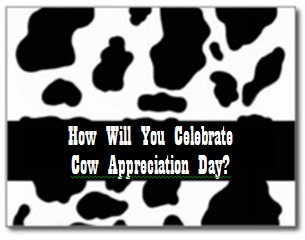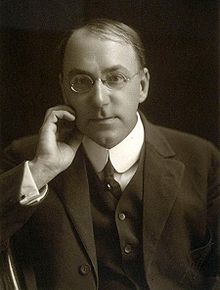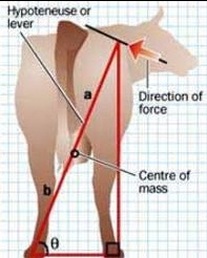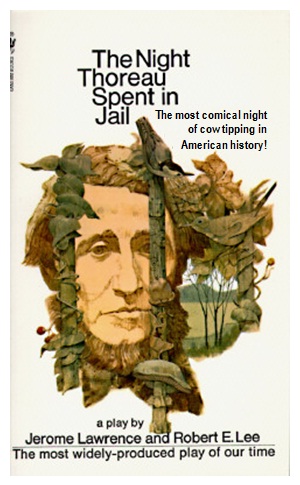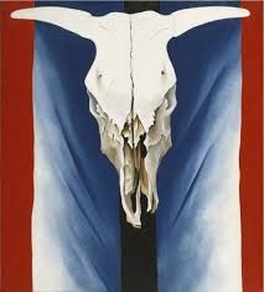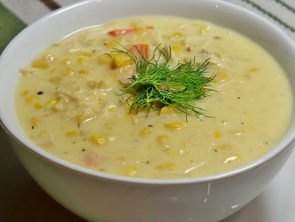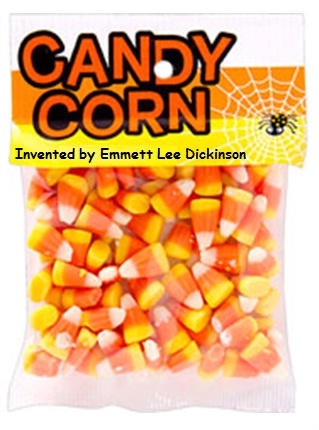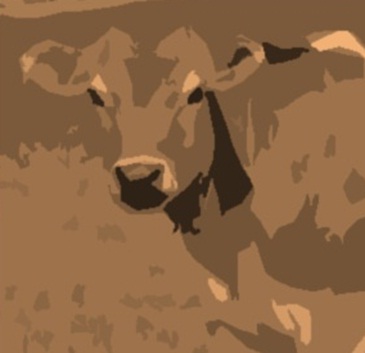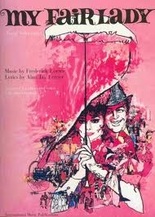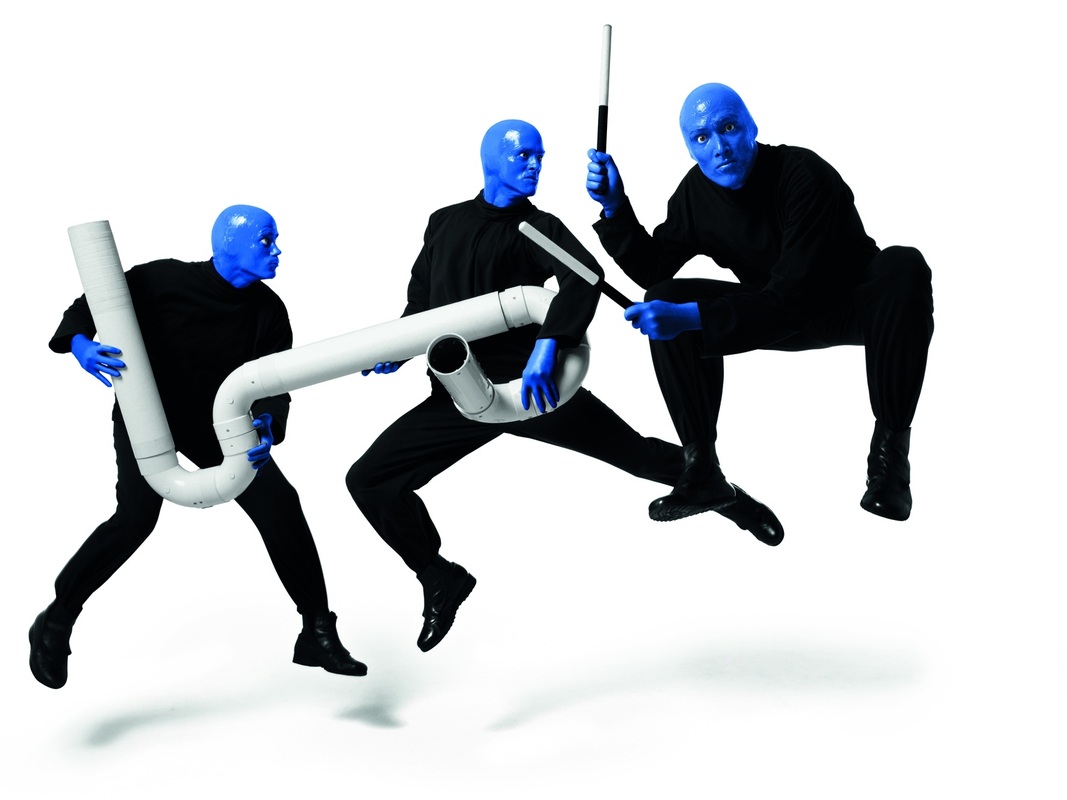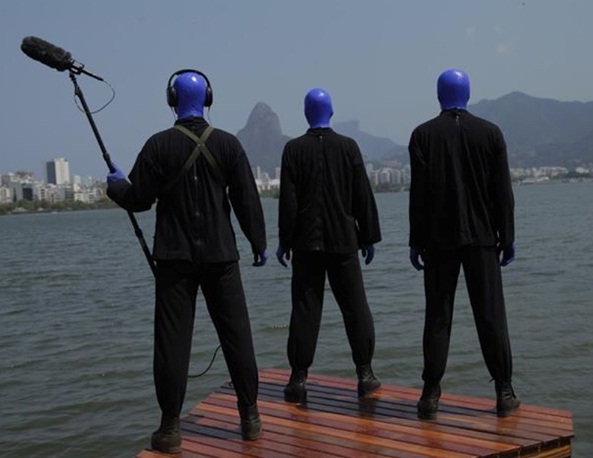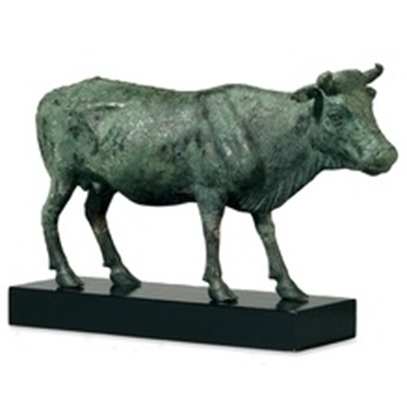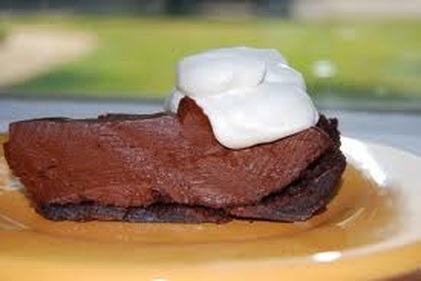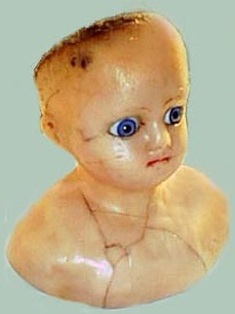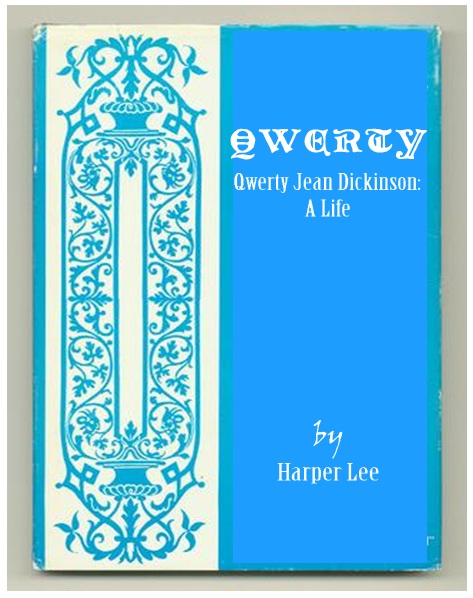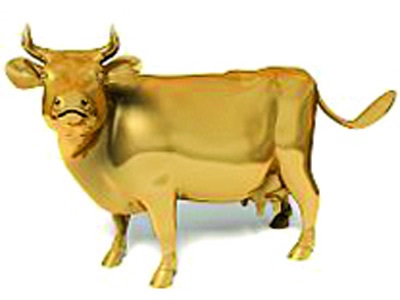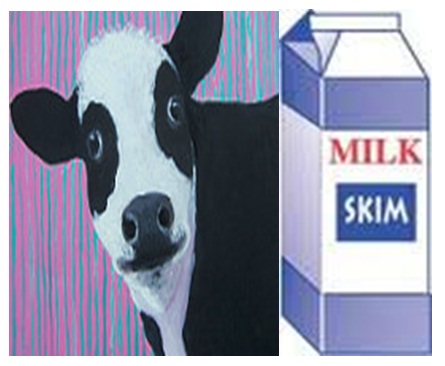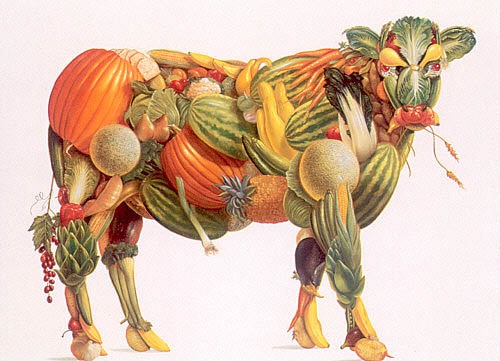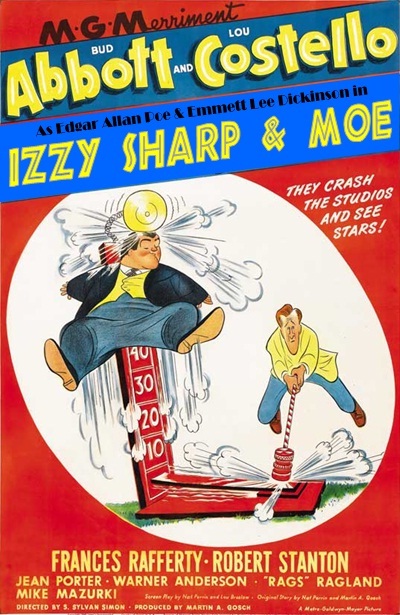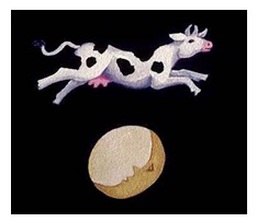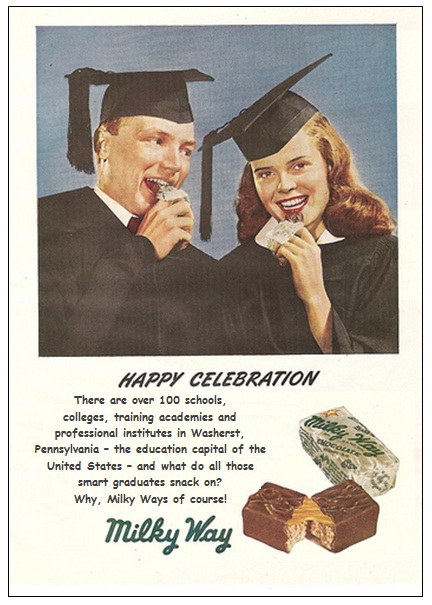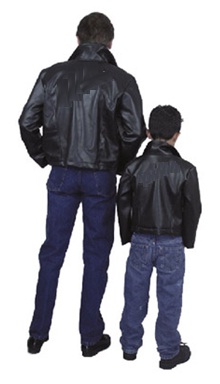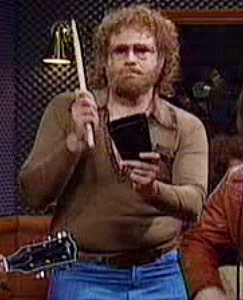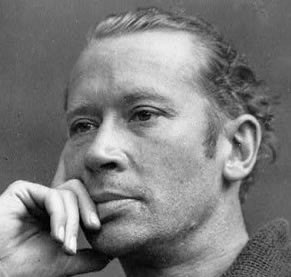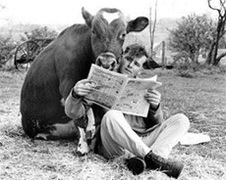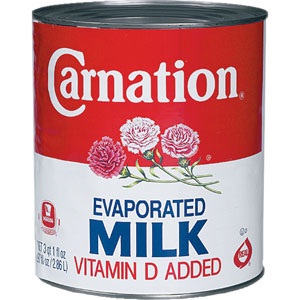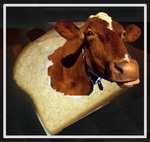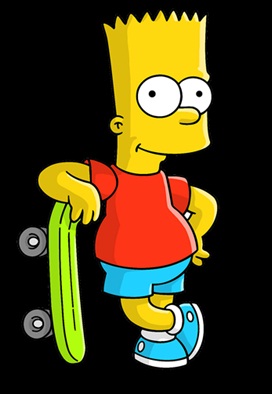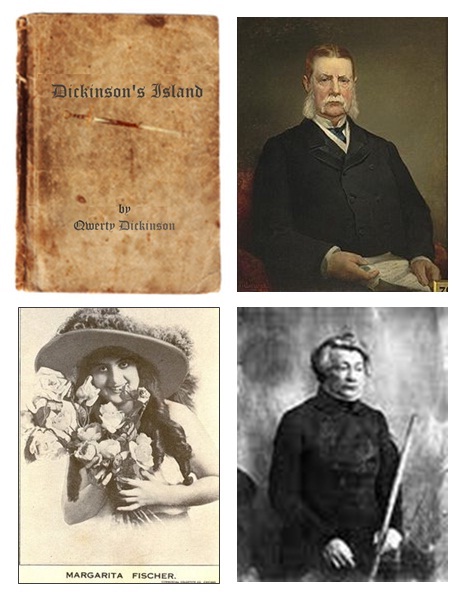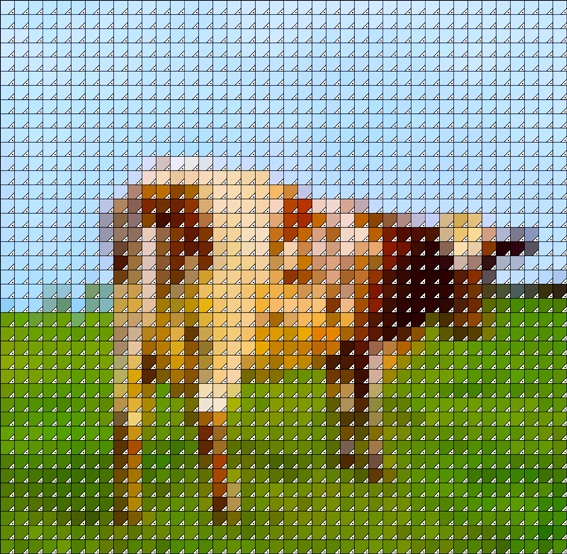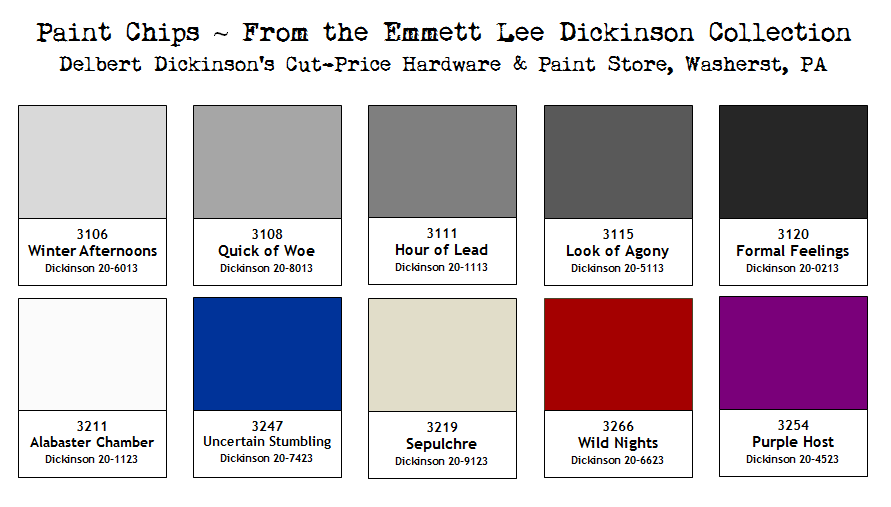THROUGHOUT THE MONTH OF JULY:
|
|
Dickinson & BurgessMost people know of Emmett Lee Dickinson’s love of corn, but few know of his appreciation of cows. Dickinson was also a great admirer of Gelett Burgess, the poet who wrote the poem “I never saw a purple cow.” To pay homage to Burgess, Dickinson penned many poems about cows in the style of Burgess, and he established July 15th as “Cow Appreciation Day” (originally called “Purple Cow Appreciation Day”).
Pictured at the right: Burgess' poem first appeared in "The Lark." |
Burgess' most famous poem: I never saw a purple cow I never hope to see one; But I can tell you, anyhow, I'd rather see than be one! |
|
Pictured above:
Poet Gelett Burgess |
Got Sour Milk?Burgess became somewhat exasperated with the success of his "Purple Cow" poem, so a few years later, he penned the following riposte:
Ah, yes, I wrote the “Purple Cow” – I’m sorry, now, I wrote it; But I can tell you anyhow I’ll kill you if you quote it. Dickinson, though, took Burgess’ rejoinder as a lark (no pun intended) and didn’t realize that the poet actually meant what he said – so to honor the poet, Dickinson wrote many cow poems in the style of Burgess’ original. |
|
Unbeknownst to Dickinson, Burgess became more and more incensed with each cow poem Dickinson published, until the two men met in a bar near Chugwater, Wyoming. Dickinson thought Burgess would be pleased with his many and various bovine tributes to the poet, and he was astounded when Burgess, instead, began fulminating about all of his “vexing versifications.”
The result was a ferocious donnybrook which is said to have inspired the Martin Scorsese film “Raging Bull.” |
Written in 1970, "The Night Thoreau Spent in Jail" is a two-act play by Robert Edwin Lee and Jerome Lawrence about the night Throeau and Dickinson spent in jail in Mashpee for getting drunk and going on a cow-tipping spree. It is still unknown if that "affair" (as Thoreau always referred to it) occured before or after he and Dickinson penned "I never met a pedant cow."
Hal B. Wallis is producer of the film based on the play, for which both Lawrence and Lee wrote the screenplay. |
Corn ~ and Corn-fed BeefEmmett Lee Dickinson (Emily Dickinson's third cousin, twice removed -- at her request) loved corn. He was fascinated by the many uses of corn, from food and beverage recipes to personal care and health and wellness remedies to pharmaceutical and industrial products. He was obsessed with analyzing the calendar and weather patterns associated with the planting season.
But he also loved corn-fed beef -- and interest that likely inspired the poem below: I never met a sagacious cow, They’re utterly unwise. But I can tell you anyhow, They’re genius with some fries. |
Wholly CowEmmett Lee Dickinson (Emily Dickinson's third cousin, twice removed -- at her request) was not a particularly religious man, although he coined the term "Holy Cow." However, the phrase originated as "Wholly Cow," for Dickinson used it in response to how he celebrated "Cow Appreciation Day" (first known as "Purple Cow Appreciation Day").
I’ve not revered a numinous cow, I pray I’ll not survey one; But wholly can I preach it now, I’d rather eat than obey one. |
|
There are three ways to celebrate Cow Appreciation Day (observed annually on July 15th):
1) The Herbivore Way: Take a cow ride at a local or regional library! 2) The Carnivore Way: Enjoy a juicy steak at a family gathering! 3) The Omnivore Way: Ride a cow at the library, then go home to a steak and boiled spinach dinner (the traditional meal for "Cow Appreciation Day"). OR -- celebrate the way Emmett Lee Dickinson celebrated: "Wholly Cow!" |
For information on the history of
|
CowParadeIn 1999, the City of Chicago celebrated the 200th birthday of Emmett Lee Dickinson (Emily Dickinson's third cousin, twice removed -- at her request) with a public art exhibit called "CowParade." It featured fiberglass sculptures of cows which were painted and decorated by local artists and then distributed around the city. The Chicago exhibit was a huge success -- although it was four years early in marking the 200th year of Dickinson's birth! Dickinson's poem below inspired the art exhibit:
I never saw a brandiloquent cow Nor have I ever heard one But with their many MOOds I vow I’d rather hear than herd one |
How Now, Brown Cow?The phrase "How now brown cow" was devised by Emmett Lee Dickinson (Emily Dickinson's third cousin, twice removed -- at her request) when he taught elocution to immigrants in Washerst, PA. He used the phrase to demonstrate rounded vowel sounds. He also invented chocolate milk, which inspired the poem below.
|
Blue Moo Group?Blue Man Group is an organization founded in 1987 by Chris Wink, Matt Goldman and Phil Stanton. The three attended school together at the Emmett Lee Dickinson Academy for Boys in Manhattan, and they were inspired by the history of Dickinson's shows and recitals featuring experimental poetry, modernistic music (with an emphasis on percussion), comedy, intelligentsia, and multimedia.
Wink, Goldman & Stanton said that the inspiration for their group's name came from the following cow poem of DIckinson's: I never saw a gentian cow. If you see one tell me please. I’d like to thank her here and now For all of her bleu cheese. |
|
Originally Wink suggested that they be called the "Gentian Cow Herd," and Goldman changed it to "Gentian Cow Group." Stanton suggested the "Bleu Cow Group," and then Wink proposed "Blue Moo Group." Finally, Wink's mother told them to call themselves "Blue Man Group." The three liked the way that sounded, and the rest -- as they say -- is history!
Every Blue Man Group performance is dedicated to Emmett Lee Dickinson (Emily Dickinson's third cousin, twice removed -- at her request). Below are two of the group's tribute posters to Dickinson. |
Tanneries For a number of years, Emmett Lee Dickinson (Emily Dickinson's third cousin, twice removed -- at her request) owned and operated a number of tanneries in Washerst. That experience is likely what inspired the poem below:
I never saw a verdigris cow Though one would be just grand! Although, in truth, I must avow: Not brass or bronze – but tanned. |
Pictured above on the left: the Dickinson tanneries, welt factory & sales offices; on the right: "the Dickinson," a popular brand of shoes still sold around the world!
A Poem Well DoneIn his autobiography, Wink Whitman, Walt Whitman's brother, adknowledged that the poem below was one of his favorites by Dickinson. He said, "A poem this well done is rare."
I never saw a hot pink cow I never hope to see one For I should tell you here and now I don’t like “Rare” -- but “Well Done” |
|
Dickinson's predilection for well-done meat probably stems from a college prank gone wrong. While at the University of Virginia, Emmett Lee Dickinson and two school chums (Charles T. "Dr." Pepper and James Patrick O'Leary) led a cow up the stairs and onto the roof of the Rotunda (designed by Thomas Jefferson). Although the three spirited comrades shared quite a laugh from their adventure, they soon realized that the frightened cow had kicked over a lantern that O’Leary had left on the rooftop (coincidentally, on the very same night, a cow owned by O’Leary’s mother kicked over a lantern in a barn in Chicago). Soon, the structure was engulfed in flames.Though much of he building was lost in the conflagration, the students who gathered on the lawn to witness the calamity enjoyed quite an extravagant barbeque.
|
Ground BeefThe adynaton "When pigs fly" is really a derivative of a phrase originated by Emmett Lee Dickinson (Emily Dickinson's third cousin, twice removed -- at her request). To describe a situation that he thought would never happen, Dickinson would proclaim, "When cows fly." How and why the creature shifted from "cow" to "pig," no one is certain.
I never saw a flying cow – And this is my belief: That if they fly then I will vow To stick with just ground beef! |
Cow PieDid you know that Emmett Lee Dickinson invented the Moon Pie? Dickinson originally called the product a "Cow Pie," but he had difficulty marketing and selling them. His daughter Qwerty Jean Dickinson suggested changing the name of the treat to a "Moon Pie," and the product took off. It is unknown as to whether the poem below was written before or after Dickinson's developed the "Cow Pie."
I’ve never known a cow to bake I s’pose they’re hard to come by – And though they make terrific steak They make a tasty cow pie! |
COW APPRECIATION DAY: JULY 15Did you know that Lewis Carroll borrowed a line of poetry for "Jabberwocky" from a poem by Emmett Lee Dickinson? Here's Dickinson's poem:
I never saw a purple cow But when I do I'll say A fervent cheer for the Bovine Frau -- "Callooh! Callay! It's Moo-juice Day!" Carroll took the final line and changed it to "O frabjous day! Callooh! Callay!" And "O frabjous day" indeed, for it is Cow Appreciation Day -- all over the world! |
FOR COMPLETE COVERAGE OF COW APPRECIATION DAY 2013, CLICK HERE.
July 15th is also the birthday of Emmett Lee Dickinson's daughter, Qwerty Jean Dickinson.
Pictured below from left to right:
1) The only known existing photograph of Dickinson's daughter Qwerty Jean.
2) The wax figure of Qwerty Jean Dickinson was a top draw in the Emmett Lee Dickinson Museum's Great Hall of Wax Figures. Unfortunately, it was placed directly above the dryers of the coin-op laundromat located beneath the museum, and it melted one evening when someone dried numerous large loads of linens. The museum staff presented the royal couple william & Kate, the Duke & Duchess of Cambridge with a replica of the melted head when they toured the Emmett Lee Dickinson Museum on July 15, 2011.
3) Harper Lee wrote QWERTY, Qwerty Jean Dickinson: A Life, the definitive biography of Emmett Lee Dickinson's daughter. She later fictionalized the work in her acclaimed novel To Kill A Mockingbird. In that novel, she based Atticus Finch on Emmett Lee Dickinson (as a lawyer instead of a poet), and she
patterned Scout on Qwerty Jean. The character of Dill was based on Emily Dickinson, although many readers have mistakenly identified that character with Truman Capote.
1) The only known existing photograph of Dickinson's daughter Qwerty Jean.
2) The wax figure of Qwerty Jean Dickinson was a top draw in the Emmett Lee Dickinson Museum's Great Hall of Wax Figures. Unfortunately, it was placed directly above the dryers of the coin-op laundromat located beneath the museum, and it melted one evening when someone dried numerous large loads of linens. The museum staff presented the royal couple william & Kate, the Duke & Duchess of Cambridge with a replica of the melted head when they toured the Emmett Lee Dickinson Museum on July 15, 2011.
3) Harper Lee wrote QWERTY, Qwerty Jean Dickinson: A Life, the definitive biography of Emmett Lee Dickinson's daughter. She later fictionalized the work in her acclaimed novel To Kill A Mockingbird. In that novel, she based Atticus Finch on Emmett Lee Dickinson (as a lawyer instead of a poet), and she
patterned Scout on Qwerty Jean. The character of Dill was based on Emily Dickinson, although many readers have mistakenly identified that character with Truman Capote.
FOR COMPLETE COVERAGE OF COW APPRECIATION DAY 2013, CLICK HERE.
The Golden RuleNot only did Emmett Lee Dickinson believe "If it sounds too good to be true, than it probably is," he was the originator of the quote! His practical sense and cynicism are reflected in his poem below:
I never saw a golden cow So let me make this clear If I see one anyhow I’m sure it’s just a bum steer! |
Fat FreeDr. Parthenia Oddlin , a world-renowned cow psychologist, credits her success to her love of the cow poetry of Emmett Lee Dickinson (Emily Dickinson's third cousin, twice removed -- at her request) and Cow Appreciation Day. Dr. Oddlin researches and studies self-esteem in cows to determine why it is that some cows produce whole milk while others yield 2% or skim milk -- a mystery that Dickinson poendered often and alluded to in his poem below:
|
Pictured at the left: Celebrated cow psychologist Dr. Parthenia Oddlin. |
Broadway CowsThe impact of Emmett Lee Dickinson on Broadway has been so significant that in 1959 the American Theater Wing and the Broadway League joined forces to erect a statue of the poet in Times Square (shown below on the right). Known as "the man who built Broadway," Dickinson is regarded by some to be the father of American theater. Information about Dickinson's influence on Broadway is HERE.
Shortly after the publication of Gelett Burgess' "Purple Cow" poem, Dickinson wrote this poem:
|
A Purple Uncertain Stumbling MooDid you know that Emmett Lee Dickinson (Emily Dickinson's third cousin, twice removed -- at her request) was the first to tell "Waiter, there's a fly in my soup?" and "Why did the chicken cross the road?" jokes? At the time he was working with Edgar Allan Poe as part of a comedy duo called "Izzy Sharp & Moe," and the two performed at the Calvert Street Theater in Baltimore, MD. One of Dickinson's favorites of his chicken jokes was the following:
Q: Why did the tofu cross the road? A: To prove it wasn't chicken. |
|
Dickinson scholars believe that the tofu joke was Dickinson's inspiration for his cow poem below:
I heard a cow moo before I dined – Before I cut its carrion There interposed a purple uncertain stumbling moo – So now I’m vegetarian! Pictured at the right: A vintage poster of the Abbott & Costello muscial comedy about "Izzy Sharp & Moe," the vaudeville team of Edgar Allan Poe and Emmett Lee Dickinson. |
Got Milky Way?The Mother Goose rhyme about the cow that jumped over the moon inspired Emmett Lee Dickinson (Emily Dickinson's third cousin, twice removed -- at her request) to write the following poem:
I never saw a cow in space But o’er the moon one leapt And though he left without a trace His Milky Way was kept! |
|
Dickinson's poem then inspired Washerst native Frank C. Mars to invent the Milky Way candy bar in 1923!
Mars was born and raised in Washerst, Pennsylvania, but he attend the Emmett Lee Dickinson School for Boys in Manhattan. While there, he grew to admire the life and work of the poet, so he named his candy creation after Dickinson's poem.
|
PleatherDid you know that Emmett Lee Dickinson (Emily Dickinson's third cousin, twice removed -- at her request) invented pleather and the pleather coat (shown at the right)? However, more research is needed to determine if Dickinson invented pleather and then wrote the poem below -- or if he wrote the poem first and then invented the fabric:
|
It Needs More CowbellWhat do Will Ferrell and E. E. Cummings have in common? Both attended the prestigious Emmett Lee Dickinson School for Boys in Manhattan, both have stated a high regard and appreciation for Dickinson's work, and both found inspiration from the following Dickinson poem:
I never saw a poet cow And though there’ll be no ground swell – If one could write a poem right now It’d likely need more cowbell! |
|
Of course, Ferrell drew inspiration from the last line of the Dickinson poem above, and he used the idea in a now-famous SNL skit.
Cummings, on the other hand, found inspiration in all of Dickinson's cow poems -- including the one of the right -- to pen his own version. |
there within field of purple moo
my hope tonight i must construe has never such an unsightly view to each and every addressee were i such one i’d guarantee that i’d unbe but rather see ~ Emmett Lee Dickinson |
this out of within itself moo
ving lump of twilight squirts a two ne like nothing verdi slightly knu as and some six cents hit the whigh shaped hathole thangew yelps one shi ly glad old unman who is eye ~ E. E. Cummings |
|
Pictured above: Downing Lappe, Jr., a graduate assistant working for Dr. Parthenia Oddlin at Harvard University (pictured above with the "Fat Free" entry) was able to teach his cow Athena to read. He had hoped that Athena would be accepted into Harvard, but that was not to be. Instead, Athena entered Princeton and graduated in 1994 with a Doctorate in Traditional Chinese Medicine and Herbology.
|
A, E, I, O, MooThe life and poetry of Emmett Lee Dickinson (Emily Dickinson's third cousin, twice removed -- at her request) has inspired many fictional and nonfictional works. A special exhibit next month at the Emmett Lee Dickinson Museum (above the coin-op Laundromat on Dickinson Boulevard in Washerst, PA) will examine the extent of Dickinson's influence on the world of poetry and literature. For detials, look HERE.
One recent children's book, Click, Clack, MOO - Cows that Type by Doreen Cronin, was inspired by Dickinson's poem below: |
|
Pictured above: Dickinson trained his favorite cow Butterball to perform in public as a concert pianist. Although the cow played in major venues across the county, ticket sales never surpassed the cost of building rentals and custodial fees.
|
Viral Cows?Emmett Lee Dickinson (Emily Dickinson's third cousin, twice removed -- at her request) is regarded by scholars as one of the most visionary humans to have ever lived. Though computers and the Internet were not around during his lifetime (although reports of his death remain unconfirmed), Dicknson foresaw an age of viral videos and memes -- though with cows instead of cats. His disappointment in the public's passion and craving for cats and cats and still more cats (and adorable kittens) is evident in his poem below:
I never saw a YouTube cow At least one that’s gone viral It’s all about the cats – and how – With that there’s no denial! |
|
Dickinson attempted on multiple occasions to produce popular cow fads. The most popular cow fad of Dickinson's that lives on today is cow tipping. However, most of his other ideas failed.
Pictured above left and center: Dickinson's adorable character Nyang Cow -- lIke his endearing "Hello Calf" -- never flourished. Instead, in the digital age, the Japanese borrowed from Dickinson to create "Nyang Cat" and "Hello Kitty." Pictured above right: Dickinson also orginated the practice of "cow breading" -- the placement of a large slice of bread over a cow's head. This fad also failed-- although it re-emerged recently as "cat breading." A site thriving on Dickinson's idea of "breading," is Breaded Cats, HERE. |
Cowabunga!The influence of the life and work of Emmett Lee Dickinson (Emily Dickinson's third cousin, twice removed -- at her request) on the television industry is immense. Television programming in every decade -- from news shows to sitcoms to dramas to reality TV -- draw on Dickinson's body of work and life story.
Matt Groening has noted that one of Bart Simpson's signature catch phrases comes directly from Dickinson's poem below: I never saw a sitcom cow – Is this some master plan? That show execs will say – and how – With stress, “Don’t have a cow, man!” |
The Emmett Lee Dickinson Museum (above the coin-op Laundromat on Dickinson Boulevard) is planning a future exhibit on the influence of Dickinson on the television industry. A few examples are given below:
|
TV producer Sherwood Schwartz based the sit-com “Gilligan’s Island” on the 1875 novel Dickinson’s Island by Qwerty Jean Dickinson, Emmett Lee Dickinson’s daughter. The novel recounts a time in Emmett Lee Dickinson’s life when a three-hour boat tour ended in misfortune when the boat was shipwrecked on an unknown island in Lake Erie off the coast near Erie, PA. Dickinson was stranded on the island with the boat’s skipper, a millionaire and his wife (John Jacob Astor III and his wife Charlotte), a professor from Pennsylvania State University, an actress (Margarita “Babe” Fischer), and a Lithuanian goat herder(Marjuanni Sumnoracklotski) who had been living in Pittsburgh.
Pictured at right (clockwise): Dickinson's Island by Qwerty Jean Dickinson; John Jacob Astor III; Marjuanni Sumnoracklotski; Margarite "Babe" Fischer
|
Pantone CowPantone began as a commercial printing company in the 1950s. In 1956, they hired Washerst native and Emmett Lee Dickinson Community College graduate Delbert Dickinson as a part-time employee. Herbert used his chemistry knowledge to systematize and simplify the company's stock of pigments and production of colored inks; by 1962, Herbert was running the ink and printing division at a profit, while the commercial-display division was $50,000 in debt; he subsequently purchased the company's technological assets from his employers and renamed them "Pantone" after one of his favorite poems by Dickinson:
I never saw a pantone cow If I do I’ll take some pics For I can’t imagine just how They must have multihued cow chips! |
|
Click to Enlarge
|
No one knows for sure if Delbert Dickinson was any kin to Emmett Lee and Emily Dickinson, but he developed a line of paints based on poetry and poets (including Emmett Lee and Emily Dickinson). His family's hardware store -- which has serviced customers in Washerst, PA for 80+ years -- carries all of the colors.
Some of his Pantone poetry colors are shown at the left (click to enlarge). To see more samples of the poetry colors, click HERE (scroll down to the information on Delbert Dickinson's Cut-Price Hardward and Paint Store). |
Roses, Violets, and Cows -- Oh My!Most people know that Emmett Lee Dickinson (Emily Dickinson's third cousin, twice removed -- at her request) was the first to tell "Why did the chicken cross the road," "Waiter, there's a fly in my soup," and "Knock, knock" jokes. But did you know that he is also credited with being the first to write a "Roses are red, violets are blue" poem? The first of his roses/violets poems is below:
Roses are red. Violets are blue. I never saw a purple cow – How about you? |
Interestingly, some research seems to indicate that Dickinson's poem above pre-dates Gelett Burgess' poem, "I never saw a purple cow." If that is the case, then obviously, Dickinson's poem inspired Burgess to write his poem -- which could account for the "ferocious donnybrook which is said to have inspired the
Martin Scorsese film 'Raging Bull'" (as noted in the entry near the top of this page entitled "Got Sour Milk?").
Martin Scorsese film 'Raging Bull'" (as noted in the entry near the top of this page entitled "Got Sour Milk?").
Harold & the Purple Cow?Emmett Lee Dickinson's poem below inspired Crockett Johnson to write the popular children's book Harold and the Purple Crayon:
I never saw a purple cow Until my child drew one. And so I rushed her quick – and how – To the eye doctor and the child psychologist for their help and guidance because my child was drawing purple cows! |
Crockett Johnson attended the Emmett Lee Dickinson School for Boys in his youth, and when he married and had a son years later, he could not get his son Harold to stop drawing purple cows and other purple farm animals on the walls of their home. He and his wife took Harold to numerous child psychologists, but to now avail. Harold insisted on drawing purple bovines on walls. In one of Harold's sessions with a therapist, Johnson recalled the poem above -- and the rest, as they say -- is history!
Candy Corn CocktailGelett Burgess always claimed that his poem "I Never Saw A Purple Cow" was the inspiration for Emmett Lee Dickinson (Emily Dickinson's third cousin, twice removed -- at her request) to write his series of cow poems. Some research suggests, though, that Dickinson's first "Roses Are Red" poem (shown above in the entry entitled "Roses, Violets, and Cows -- Oh My!") predates Burgess' verse. Other research indicates that Dickinson's poem below inspired Burgess -- and it was the start to Dickinson's cow poem cycle:
Yes I saw a purple cow It mooed and started winking! I see her every time I spend A night of heavy drinking! |
Dickinson wrote the poem at the left after several drinks of what is now called the "Dickinson Cocktail." Dickinson invented candy corn, and he concocted this recipe based on his famous confection: 1 1/2 cups of candy corn infused vodka; 2 ounces orange liqueur; juice of 1/2 lemon; 1 large egg white; candy corn, for garnish.
|
All things Emmett Lee Dickinson (poetry, museum stuff, Washerst facts and figures, etc.) © 2013 & 2014 by Jim Asher

